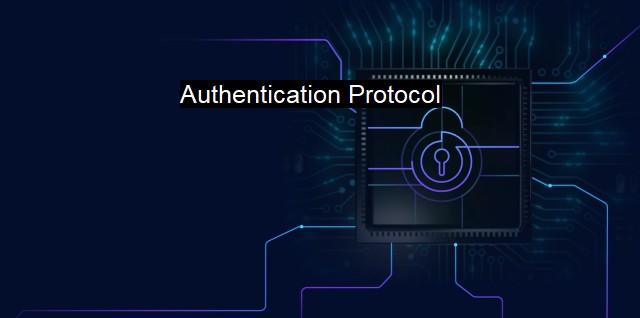What is Authentication Protocol?
Exploring the Importance and Functionality of Authentication Protocol in Cybersecurity and Antivirus: A Comprehensive Overview
An authentication protocol plays a crucial role in verifying the identities of communicating entities. Also known as verification processes, these essential sets of rules streamline secure communication through the validation of users, systems, or networks and contribute to ensuring the irreversible encryption of information. In basic terms, an authentication protocol's goal is to confirm a user's identity before giving that user access to network resources or secure data.Authentication protocols are pillars of cybersecurity, propagating trust and security across electronic communication systems by establishing or heightening protective barriers to unauthorized access. All the more crucial with the escalating adoption of the Internet for daily life, business operations, and governmental functioning - the application of authentication protocols limits the degree to which cybercriminals can exploit electronic data.
Generally, authentication protocols are part of a larger framework for cybersecurity, functioning systematically with encryptions, antivirus solutions, firewalls, and more to create a holistic line of defense. At its fundamental core an authentication protocol works in the foreground of this security synergy to verify the authenticity of a user or a system.
The journey of an authentication protocol involves a set of procedures. After a user provides an identifier—like a username or an email address—the authentication protocol then verifies the given credentials against a database. Each account in the system has a unique hash associated with it. A hash is a numerical value generated by a function, which is typically unique to each user. This aids in verifying the individual's identity without posing the risk of data exposure because the hash cannot be reverse-engineered to reveal the original piece of information.
From simple password-based systems to complex data-encryptions, multi-factor, and biometric verifications – the landscape of authentication protocols continues to evolve, growing more impregnable by the day. Simultaneously, with the varied types of authentication protocols in place today, different protocols adopt unique tactics to secure information, with each differing in their operation and levels of security.
In the context of antivirus solutions, authentication protocols hold dual roles: preventing unauthorized traffic or potentially hazardous software from infecting the system and negating security threats emerging from within the network. By enabling identity verification and profile differentiation amongst users, authentication protocols curtail the possibility of internal security breaches, thereby enhancing the efficiency and effectiveness of an organization's cybersecurity framework.
Despite advances in these authentication mechanisms, they are not immune to cyberattacks. Sophisticated hacking techniques have been developed that compromise these authentication protocol defenses—they have the ability to steal credentials, impersonate users, and much more.
This emphasizes the crucial duty for incessant innovation and upgrading of existing authentication protocols to combat ever-evolving cyber threats. While robust, the authentication protocol is not a standalone solution and requires other security measures, like encryptions, antivirus software, firewalls, etc., to create a well-rounded security barrier. For an optimal cybersecurity approach, an authentication protocol needs to strike a balance between user convenience and maximum security.
Authentication protocols provide a critical front-line defense identifying and verifying users and systems before allowing access to potentially sensitive data or resources. Given the continuous evolution and sophistication of cyber threats, their implementation and regular upgrade are vital to the continuous safety and security of our online world. Without a doubt, authentication protocols are massive contributors to the field of cybersecurity and are set to remain central players as the digital world continues to expand and develop. End of the story.

Authentication Protocol FAQs
What is an authentication protocol?
An authentication protocol is a set of rules and procedures through which a system verifies the identity of a user or device accessing it. It is an essential component of cybersecurity that ensures only authorized entities gain access to resources and data.What are some commonly used authentication protocols in cybersecurity?
Some commonly used authentication protocols in cybersecurity include Kerberos, LDAP, RADIUS, and OAuth. These protocols help to establish secure connections, verify the identities of users, and grant access to protected resources.What is the importance of authentication protocols in antivirus software?
Authentication protocols are critical in antivirus software as they help to prevent unauthorized access to users' systems and data. They establish secure communication channels between the antivirus software and other components of the system, ensuring that only authenticated entities can access the system. This helps to protect against malware, phishing attacks, and other cybersecurity threats.How can organizations ensure the effectiveness of their authentication protocols?
Organizations can ensure the effectiveness of their authentication protocols by implementing best practices such as using strong passwords, multi-factor authentication, and periodic reviews and updates of their security policies. They can also conduct regular security audits and penetration testing to identify vulnerabilities and improve their security posture.| | A | | | B | | | C | | | D | | | E | | | F | | | G | | | H | | | I | | | J | | | K | | | L | | | M | |
| | N | | | O | | | P | | | Q | | | R | | | S | | | T | | | U | | | V | | | W | | | X | | | Y | | | Z | |
| | 1 | | | 2 | | | 3 | | | 4 | | | 7 | | | 8 | | |||||||